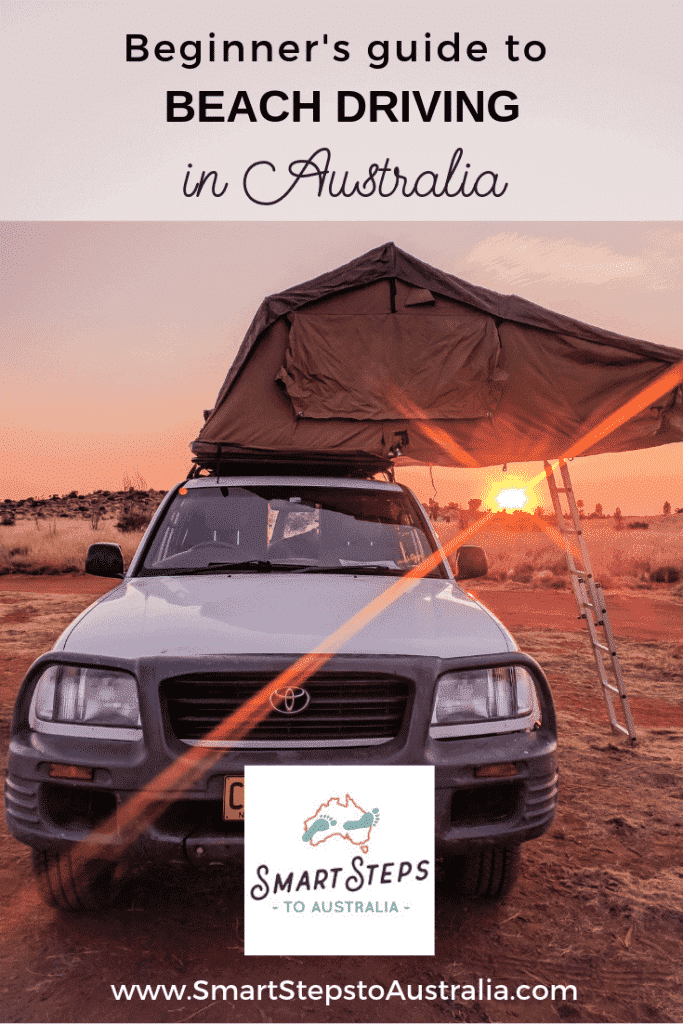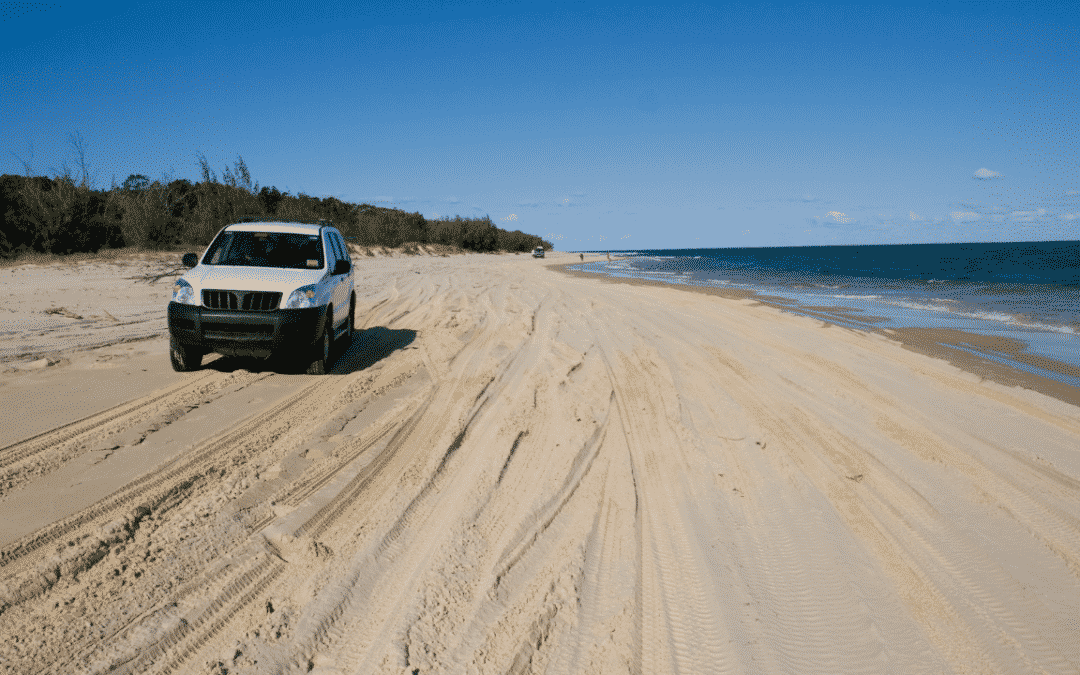When most of us move to Australia, we’re excited about the prospect of travelling in Australia and enjoying the Aussie outdoor lifestyle. Getting out on the beach is a big part of that!
I’ve been on lots of beach tours where I’ve gone on a 4×4 off-road adventure on a beach – I did it at Noosa, K’gari Fraser Island and Rainbow Beach. I’ve never actually driven on the beach myself though! A beach drive is a pretty scary concept for someone who didn’t grow up with the experience of beach driving. There are so many things you need to be aware of before you set off on that first beach drive so you need to be prepared and learn how to drive 4WD on the sand.
Although we recently switched the tyres on my 4WD car to off-road tyres to give us a bit more flexibility my car is, unfortunately, a bit low for proper off-road driving on sand. Our long-term plan is to buy a bigger 4WD car next time so we can go on some proper off-road adventures (and maybe also buy ourselves a caravan which is a big dream of ours when we’ve finished renovations on our house which seem to be taking forever!). So at some point, I’ll be searching for the best car for beach driving in Australia but, for now, I’ve reached out to some other bloggers to get their beach driving tips.
Fancy trying beach driving in your 4WD? This post about driving on sand will help prepare you for taking your first off-road beach drive in Australia!
This post about 4WD tips for beginners contains affiliate links.
Tips for 4WD driving in Australia
A few of you have asked me how to get started with beach driving, so I put the call out to the travel blogging community who have way more experience in beach driving than I do and I asked them to share their top tips to make your first 4WD adventure an incredible experience.
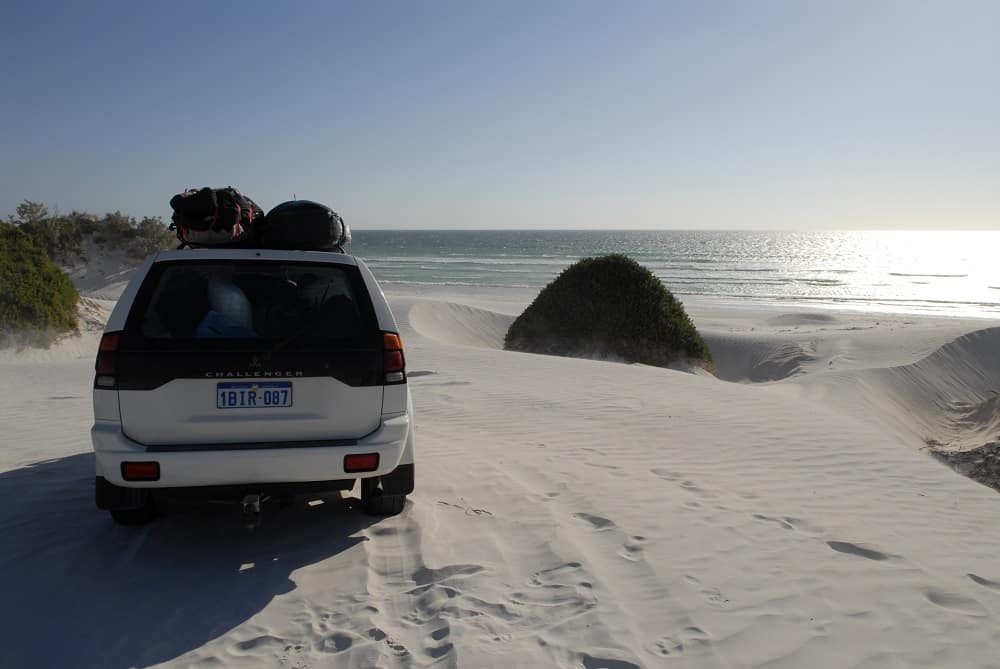
Image by West Australian Explorer https://www.westaustralianexplorer.com
Don’t forget to pack everything you need for your beach day, including your portable BBQ and mosquito repellent!
Sand driving tips for driving on sand in Australia
Australian off-road driving is incredible – it means you get to see a whole part of the beach that you’d miss if you didn’t give beach driving a try. Take Rainbow Beach, for instance – if you didn’t get out on the sand highway you would totally miss all of the beautiful colours in the rocks up close. A beach drive takes you away from the crowds where you can really explore the pristine environment on a more personal level. But it does come with some challenges!
If you have a 4WD in Australia, now is the time to learn how to beach drive with these top 4WD tips for beginners!
4WD tips for newbies: Let some air out of your tyres & bring 4WD accessories with you
Lisa from Run Eat Sleep Repeat shares her top tips for 4WD off-road driving:
‘Letting a little bit of air out of your tyres helps them travel more easily over soft sand dunes without getting bogged. It’s important to remember though, that your vehicle will handle differently with softer tyres, so drive carefully and steadily. Avoid doing sharp, fast turns as this can lead to your tyres rolling off the rim, or your vehicle rolling over, and then you’ll be in all sorts of trouble!
After you’ve been driving on the beach, and have returned to the bitumen (or a more stable unsealed road), you’ll need to re-inflate your tyres.
So remember to pack a portable air compressor and tyre gauge!’
My main take aways: I have heard lots of people say you need to let your tyres down a bit before you drive on sand, but I hadn’t thought about packing a portable air compressor and tyre gauge for when you get back onto the road again!
Extra resources: Learn more about tyre pressure for sand on WhichCar.
Essential 4WD Accessories: Portable air compressor to reinflate tyres
>> Shop for portable air compressors on Amazon
4WD for beginners: Be aware of your fuel when beach driving in Australia
Rochelle from Love Family Life Travel shares her top sand driving tip below:
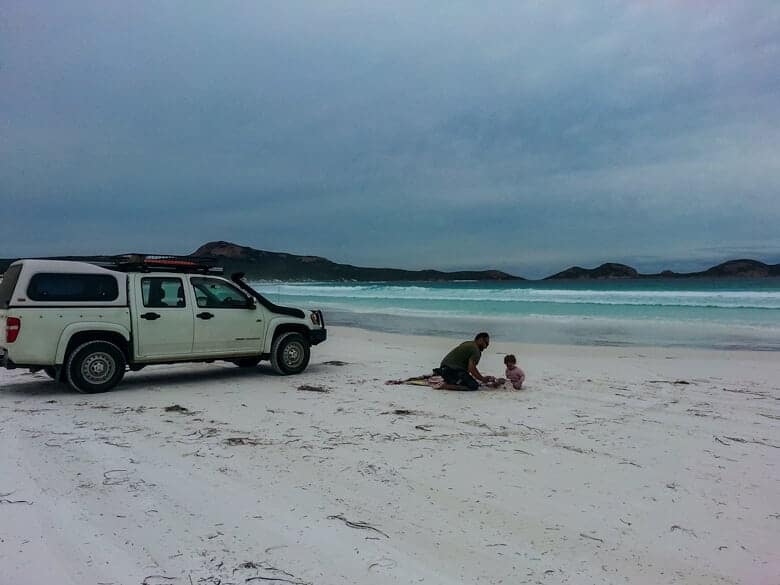
Image by Love Family Life Travel www.lovefamilylifetravel.com
‘My top tip for beginners learning to beach drive is to make sure you have enough fuel in the tank. You will chew through a lot more petrol, than you expect to.
We planned to do a 30km beach drive near Yalgorup National Park, south of Perth, one Australia Day long weekend. Preston Beach was like a highway, with hundreds of cars parked up in intervals. Most were settling in for the day with awnings and shelters out, and fishing rods cast. We even spotted a couple of full-sized barbeques on the back of some utes.
We had never done the drive before, but we had looked at the map. It was about 30km from Preston Beach to Binningup Beach. We had a quarter tank of petrol. Should be plenty (we thought) for a 30k drive.
Beach driving can be slow going. We were especially cautious because there were heaps of kids playing in the sand.
We drove for about an hour and we still hadn’t come across the exit at the next beach. We had been watching the petrol tank dip lower and lower until we were quite concerned we weren’t going to make it.
We had no idea how far we had come (we hadn’t checked the odometer when we started) so we had no idea how much longer we had to go.
When the fuel light came on we pulled over and asked some campers how far it was to the next beach exit. They didn’t really know and said they thought it was still about 10km. They had entered the beach from the same place we had.
We didn’t know for sure how much further we would have to drive or where the closest petrol station was when we would exit. We knew there was a petrol station right where we started so we decided we had to turn back.
We made it to the petrol station without conking out and we learnt a valuable lesson that day.
Make sure your tank is full of petrol before beach driving.’
My main take aways: Eek – that sounds pretty hairy. Obviously, make sure your fuel tank is full before setting off but a couple of other things I took away from this tip is to check your odometer reading before getting started to give you a clear idea of how much further you have to go until the next exit and make a note of it, and also check out where the nearest petrol station is at the point where you are planning on coming off the beach while you still have wifi!
Extra resources: Find petrol stations around Australia on FuelMap.
How to drive on a beach: Take notice of your surroundings
Simon from Journeys to Adventure shares his 4WD Australia beach driving tip:
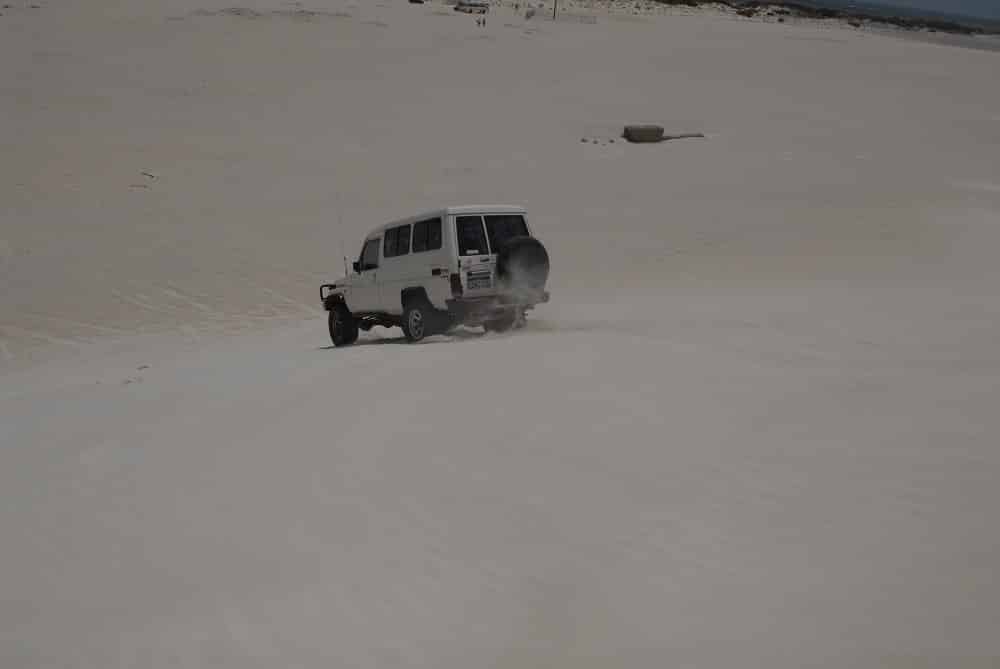
Image by West Australian Explorer https://www.westaustralianexplorer.com
‘Driving on beaches is fun, I’ve driven a lot on sandy white beaches. Growing up surfing on the isolated West Australian coastline has some benefits.
I have been stuck (bogged) in the sand way too many times in my younger years. Though these days I tend to have some experience to reflect on.
One of the bigger mistakes I used to make was not paying attention to how soft the sand was and getting totally bogged. Like right up to the axles with an incoming tide (scary). So, my tips with dealing with the soft sandy beaches are the following:
- If possible, don’t drive on soft sand. But if you have to, don’t go too near the water’s edge and drive directly on previous car tracks if available. The previous car would have compacted the sand, making it firmer to drive on.
- Don’t drive on a beach after a storm and be cautious during the winter months. When high swell and tides break on the beach, it softens the sand making it like quick sand for your car. Summer is the best time for beach driving, the beach has had time to settle and compact making the sand firmer to drive along.’
My main tip about how to drive on a beach: Be aware of your surroundings when driving in Australia on the beach. You need to be aware of the sand in front of you, the tide times and the weather. You are likely to make some mistakes when driving on sand, but learn from them so you can avoid making them again! Driving in Australia means keeping an eye on the weather here as it can quickly turn extreme, so check beach weather conditions before you leave even if it looks like it’s going to be a clear, sunny day!
Extra resources: Find weather updates on BOM. You can also read this post about living with the extreme weather in Australia.
Beach driving equipment: Be prepared in case you get bogged while driving on sand
Nina from West Australian Explorer shares her top tips for beach driving in Australia:
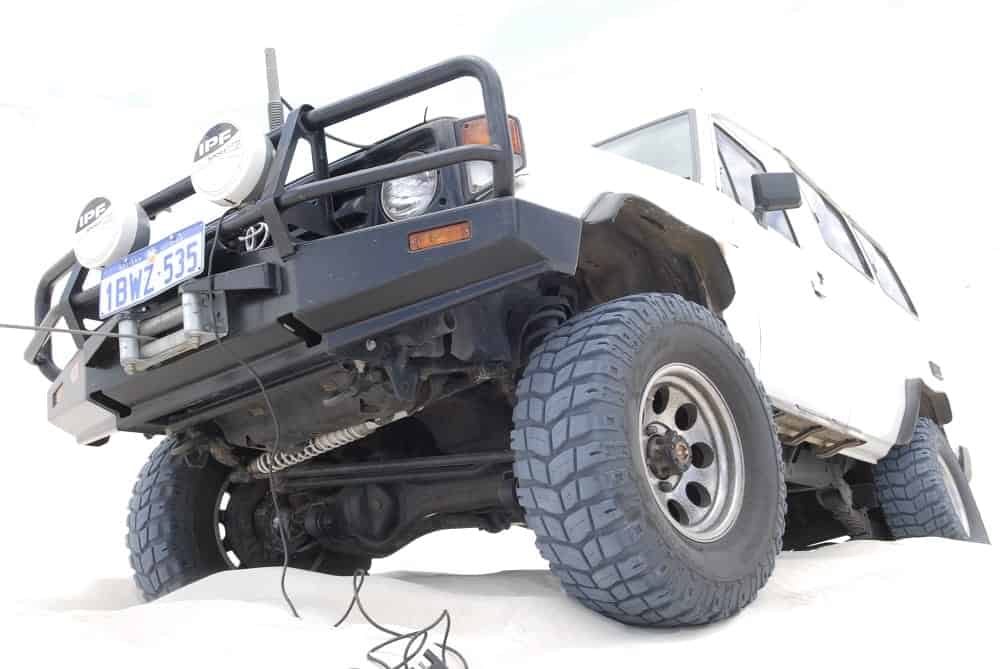
Image by West Australian Explorer https://www.westaustralianexplorer.com
‘If you do plan to go beach driving, chances are that you’ll probably get bogged. That’s all part of the fun, right? To avert any major disasters though, being prepared with the essential recovery gear and the right beach driving equipment is an absolute must. This ensures that you can get unstuck on your own and avoid becoming someone else’s liability.
The beach driving equipment essentials when it comes to recovery gear is a shovel – many insist on this being long-handed for extra leverage, snatch straps, shackles and gloves. If you do have to use the snatch strap, play it safe at all cost and keep spectators well away. The snatch strap acts like a rubber band and has caused some serious injuries to bystanders when it inadvertently came undone from the vehicle.
Another essential item is the MaxTrax or other recovery tracks. Many regular beach drivers swear by them because they’re so easy to use. Simply use the Maxx Trax to dig out some sand in front of the tyres lay it under the wheel and you should be able to drive out without too many complications in most situations.’
My main take aways: Pack yourself recovery gear so you’re prepared as and when you get bogged! Don’t rely on other drivers having a recovery kit you can use or even on other drivers turning up when you need help – be prepared to get yourself out of any trouble if you can.
Extra resources: Read these tips about getting bogged on Australian Geographic.
Essential 4WD Accessories:
4WD recovery gear
Make sure you travel with 4WD recovery gear when you go for a beach drive and pack a shovel.
>> Shop for a 4WD recovery kit on Amazon
4WD tracks
Take 4WD tracks with you when you go on a 4WD off road drive
>> Shop for a 4WD recovery kit on Amazon
More driving on sand tips for 4WD driving: Beach driving for beginners
While I’m not a beach driver myself, I have a few of my own sand driving tips to add to those above from what I’ve learned as a passenger and a regular traveller.
Follow the rules when off-road beach driving in Australia
Yes, beaches are treated like roads so you need to have a read of the road rules for beach driving. Here is a link to the Queensland Government Department of Environment and Science rules and tips for driving on sand and you should check out the equivalent rules in the state you plan on doing your beach drive.
There are speed limits on the beach and you still need a license to drive so it’s not a place to let your teenager have a go at the wheel. Check out the road rules before you set off. And make sure your kids understand the beach is actually a road so they are aware of the dangers of their surroundings – it’s easy to forget the dangers when you’re playing in the sand.
Find out why life is better at the beach!
Pack supplies for your beach drive
You may not be intending to spend the night on the sand, but it’s a good idea to pack some basic food and drink supplies and a torch for emergencies as you never know what could happen. It’s also essential to pack a good first aid kit and blanket. You never know when you may need this for your own family, or to help someone else out as you drive along the beach. Be prepared for the unexpected.
Get a travel first aid kit from Amazon
Taking a beach shelter or a 4WD canopy and sunscreen is also important as you’re going to be in the open sunshine when you stop for the day.
Consider taking 4WD training course for beach driving
If you’re still worried about how to drive a 4 wheel drive on sand, there are a number of off-road driving schools offering a 4×4 driving course to teach you basic driving on sand skills and sand driving techniques. You can get 4×4 training from a 4×4 driving school that will teach you how to drive a 4 wheel drive at the beach safely in a short 4WD course lasting just a day. There are also groups where you can go out for a longer trip as part of a 4WD course teaching group while also enjoying an Australian off-road holiday! Some off-road training will do wonders for your sand driving confidence.
A 4WD course will teach you the basics and give you plenty of tips for driving in sand and they’re a lot of fun as I have a few friends who’ve done them before. It’s something I think I’ll do when we get a suitable vehicle to give us a bit of confidence in driving on sand.
Don’t assume your 4×4 can drive on the beach
A small 4WD may be too low to cope with beach driving (like mine). Just owning a 4WD vehicle doesn’t mean you can automatically give beach driving a try – your 4WD needs to have off-road tyres on it to cope in the sand, too. If you buy a car second hand, you may find it has been fitted with road tyres (like my Jeep had), so check whether you have sand tyres before you set off on your first beach drive!
Check your 4WD insurance covers you for driving on a beach!
If you plan on driving on sand, make sure you check your 4WD car insurance policy to check you are covered for beach driving. While most car insurers will generally cover you for incidents that occur on the bitumen, they are less likely to cover you if you’re stuck in the mud or bogged in a sand dune! It’s also worth considering your 4WD accessories too as you may want to have them added to your car insurance policy or added to your home insurance policy (LED headlights, tyres, bull bars, roof racks, 4WD roof top tents, or any other mods or 4WD gear that you may have added to turn your 4WD into an off-road adventurer.
Consider going in a tag team for your first sand drive
If you don’t feel confident with off-road driving and you don’t know how to drive on the beach, it can help to go as part of a convoy with friends who might be more confident and who have vehicles that can be used to pull you out if you get bogged in the sand. Safety in numbers!
Take care of the environment!
There won’t be any rubbish bins nearby when you’re beach driving, so be considerate to the planet and wildlife and take your rubbish home with you! Please don’t even leave food waste behind – animals might eat it and it may be something they should eat. Leave nothing behind but your tyre tracks in the sand and your happy memories. If you’re going to be camping on the beach for a while, invest in a pop up camping rubbish bin.
Buy a camping pop up rubbish bin from Amazon
Or just take some bin liners along with you!
Thinking of camping during your off-road adventure? Read this post about camping essentials for beginners.
Want more inspiration about how to drive on sand in a 4×4?
Check out these resources about off-road driving and driving on the beach..
Buy 4WD Driving Skills: A Manual for On and Off Road Travel from Amazon
Get 4WD Handbook: The Complete Guide to How 4WDs Work and How to Drive Them
Sand driving: Tips to enjoy your off-road adventure and get your driving on the beach
4WD off-road driving is a lot of fun if you plan for it and if you’re prepared by packing the right 4WD equipment. I hope this post has inspired you to give 4WD off-road driving on the beach a try!
Enjoyed this post? You might enjoy these next…
Learn about choosing a beach wagon
Find out about zinc sunscreen in Australia
Read my CoolCabana beach shade review
